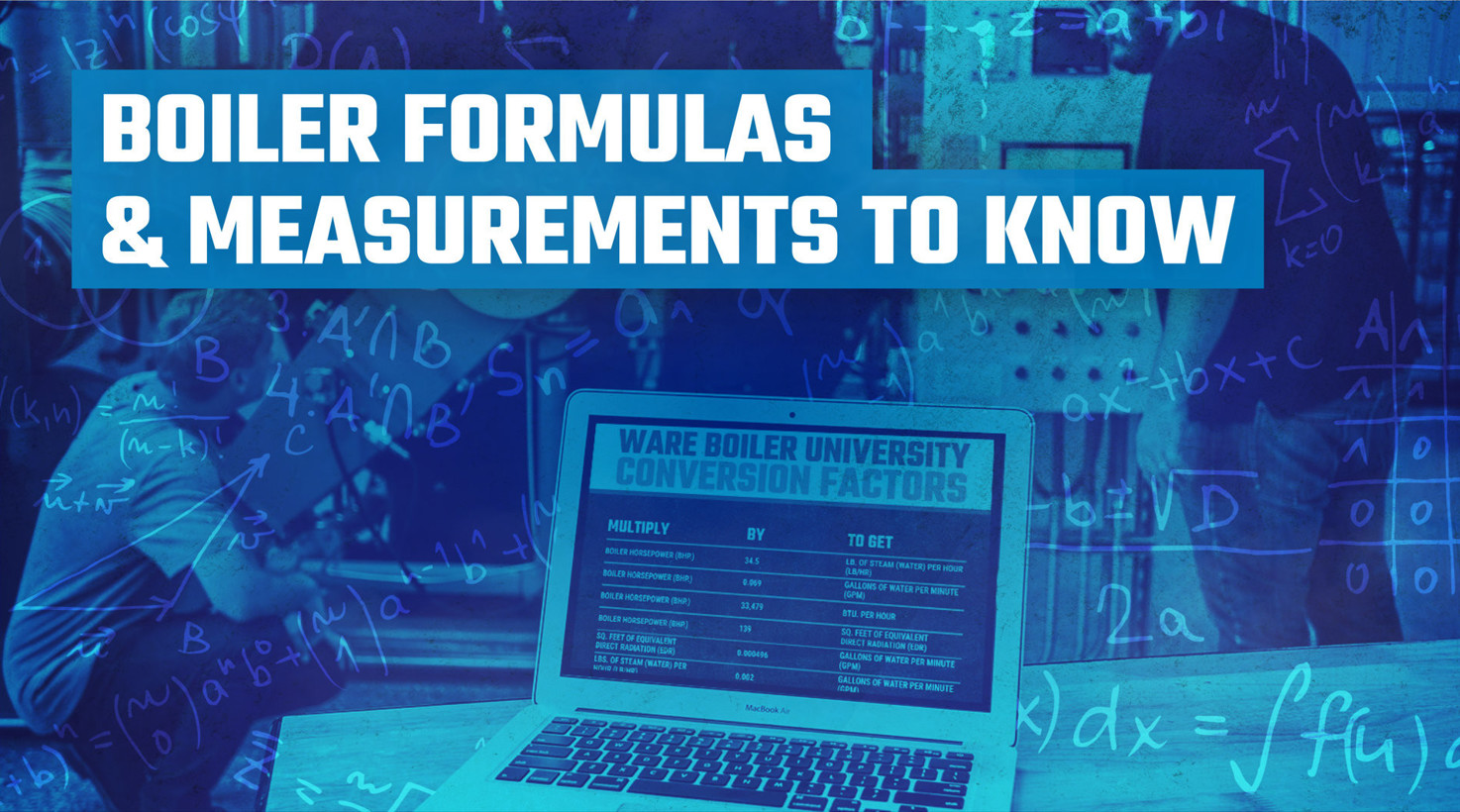DOING THE MATH: THE FORMULAS BEHIND BOILER OUTPUT
If you’re in the market for a new or rental boiler, WARE has a massive number of them in stock. So how do you know which one to choose? You ask an expert. WARE has made it easy to figure out the ideal system for whatever you need. After all, the size of your boiler is probably the most important decision you’ll make.
There are a series of formulas that are available for download here. They are used to calculate a lot of things, including boiler performance, and the sizing of a new boiler for the desired application. As an example, we’ll be determining the amount of fuel and water that will be required to keep a 300-horsepower boiler running.
AMOUNT OF STEAM NEEDED
A boiler that can’t keep up with demand is pretty useless. That’s why the first thing to determine for our formulation is the amount of steam the boiler needs to generate over a given period of time, known as generation capacity. Once we start with that, we’ll be able to determine how much fuel and water will be needed to keep the boiler operating properly.
FUEL SUPPLY
In order for a boiler to generate steam, it needs heat. That heat comes from fuel, most commonly natural gas, propane, or oil. Each of these fuels is capable of producing a specific amount of energy for a given volume. In other words, if we know how much we have in a container, we can easily calculate how many Btus of heat it will produce when burned. Since the fuel source’s energy is constant, then, the only way to adjust the amount of heat generated is by changing the flow. That’s why fuel supply rate is a crucial part of our calculations.
WATER SUPPLY
As a boiler generates steam, the water volume in the boiler is going to go down. You have to be able to resupply enough water to keep the boiler running at capacity, so the water level doesn’t drop too low. That’s why water flow is another crucial variable in calculating the correct boiler size. It’s not just about what’s coming out of the tap, either. The water inside your boiler has to be properly softened, conditioned, and treated before it feeds the boiler. So what you’re really going to need to know is how much water your deaeration, preparation, and conditioning systems can generate.
Now that we know all the variables we’re going to be dealing with, it’s time to actually do some calculations. Let’s assume that our boiler will have to operate at a capacity of 300 horsepower.
To get the pounds of steam needed per hour, we multiply horsepower by 34.5, which gives us a total of 10,350 pounds per hour. We now know our boiler is going to have to generate 10,350 pounds every hour, but we also know that’ll take a lot of heat energy to create that much steam. We need to make sure we have enough fuel flowing in to keep our boiler going.
Let’s assume it’s a natural gas boiler. Natural gas contains about 1000 Btus of heat per every standard cubic foot delivered per minute. To get the Btus per hour it’ll take to generate those 10,350 pounds of steam per hour, we multiply boiler horsepower (300) by 33,479, which gives us a total of 10,043,700 Btus needed every hour the boiler operates.
To calculate the required fuel flow rate, we divide the total required number of Btus by the Btu rating of our fuel. So we know that at 1000 Btus per standard cubic foot, a boiler needing 10,043,700 Btus per hour will require a fuel flow rate of 10,044 cubic feet of natural gas per hour. That means if you want your 300 horsepower, you’re going to have to have a gas supply that can deliver enough volume.
A boiler isn’t just going to use fuel, though. It’s also going to lose water as it makes steam. That means the pumps running from the condensate tank to the boiler have to be able to deliver enough water to keep the steam cycle moving along at full tilt.
To calculate the amount of water the pumps will need to supply, we multiply the horsepower (300) by 0.069 to determine the gallons per minute our pumps will have to handle. That means the pumps must be able to deliver 20.7 gallons per minute. Typically, pumps are rated at twice the necessary capacity, which means this installation would require pumps that could put out 41.4 gallons per minute.
If a modulating feedwater valve is used, the feedwater capacity is usually specified at 1.5 times the required flow rate, because modulating feedwater valves can adjust the flow in smaller increments to more accurately keep up with demand.
NOT JUST FOR NEW
These formulas can be used for a lot more than just sizing a new boiler. In fact, keeping them handy can help you monitor the ongoing performance of your boiler. That way you can keep tabs on your fuel and water usage, and spot any problems that start to develop before they become major headaches.
There’s a lot that goes into sizing, operating, monitoring, and inspecting a boiler. The experts at WARE are your go-to resource for everything you need. We have the services and parts you need to keep your Typically, boiler running properly. We also have the technical expertise to keep them properly inspected and operating at peak efficiency. If we can help in any way, please let us know. If you’d like to know a little more (or a lot more) about how boilers operate, we encourage you to sign up for one of our WARE Boiler University classes. Each one provides extensive classroom and hands-on instruction with fully functioning boilers, taught by industry experts. Virtual classes are also available.
